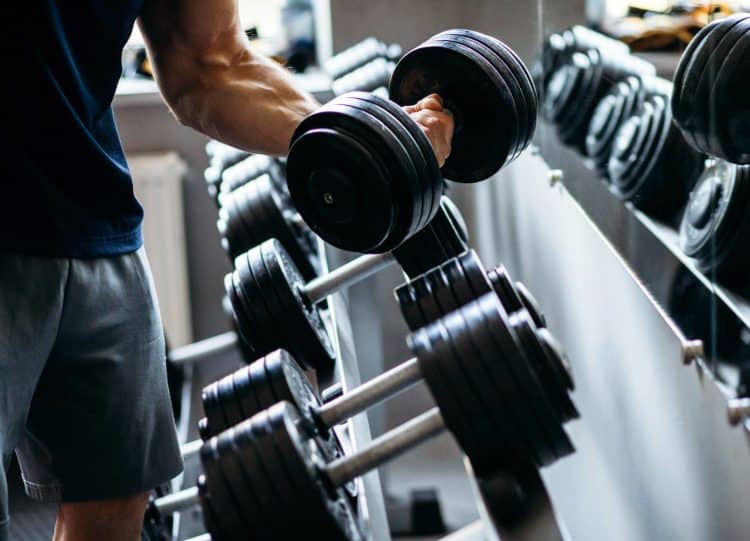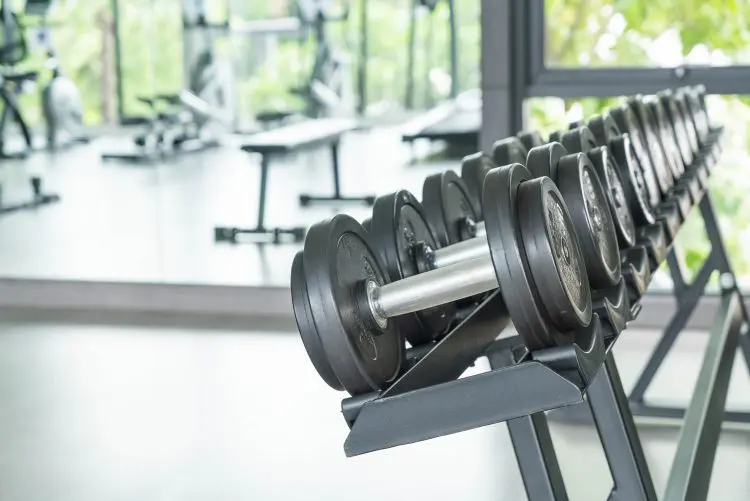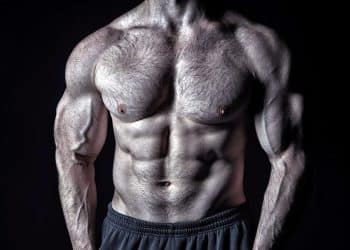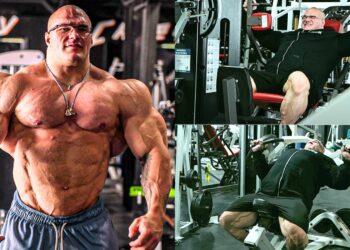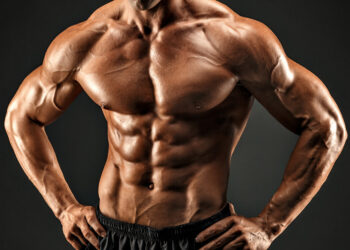If you believe everything you read about strength training, you would be forgiven for thinking that the only way to get an effective workout is by using lots of training equipment. According to more than a few experts, you need access to barbells, dumbbells, machines, suspension trainers, resistance bands, chains, and a whole bunch of other things to shock your muscles into getting bigger and stronger.
While such a holistic approach definitely works, effective training doesn’t have to be complicated. Not so many decades ago, workout enthusiasts got fitter and stronger using very little equipment; sometimes just a pair of dumbbells or a fixed-weight barbell.
When you bought your weights, you also got a workout program to follow. Weider strength training products were especially famous for this.
Contrary to popular opinion, productive workouts don’t have to involve lots of different training methods or equipment.
In this article, we reveal the ten best dumbbell chest exercises you can do without a bench and provide you with a workout to follow, too.
Can I Build My Chest Without a Bench?
It’s not the bench that builds a bigger chest; it’s your dedication and consistency. The bench press is surely an excellent exercise to add mass and strength to the chest, but that doesn’t make it the only way to train your chest.
Level Up Your Fitness: Join our 💪 strong community in Fitness Volt Newsletter. Get daily inspiration, expert-backed workouts, nutrition tips, the latest in strength sports, and the support you need to reach your goals. Subscribe for free!
Several exercises can help build a stronger chest without a bench. Exercises like the dumbbell floor press, dumbbell floor fly, dumbbell Svend press, feel-elevated push-up, plyo push-up are great exercises to train the chest.
Be with us till the end, and we will discuss a wide range of chest exercises that can be done without the bench. Plus, we will also provide chest training programs for beginners, intermediate, and advanced lifters.
Chest Anatomy
Understanding anatomy can help you target the desired muscle fibers more efficiently.
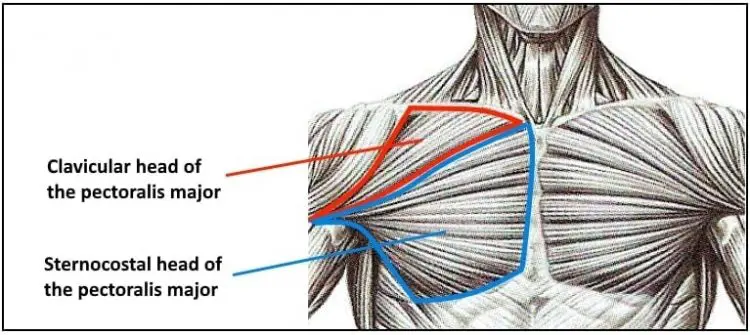
Pectoral muscles are responsible for pushing movements and consist of the pectoralis major, pectoralis minor, and serratus anterior.
- Pectoralis major: It’s a fan-shaped superficial muscle that spans across the chest. Pectoralis major is further divided into two muscles: the clavicular head (upper chest) and the sternocostal head (middle and lower chest) and is responsible for the flexion, adduction, and internal rotation of the humerus.
- Pectoralis minor: It’s a deep muscle that recedes underneath the pectoralis major. The primary function of the pectoralis major is to stabilize the scapula.
- Serratus anterior: This is the muscle that attaches ribs to the scapula. This muscle consists of several strips, each attached to the lateral side of ribs 1-8. The serratus anterior is responsible for the scapular protraction. The dumbbell pullover is one exercise that strengthens the serratus anterior.
16 Best Dumbbell Chest Exercises
The bench press (barbell or dumbbell) is one of the most popular and effective chest exercises you can do. That said, it’s not the only way to build your upper body. In fact, you can get a great workout using just a pair of dumbbells.
You can also use a stability ball instead of an exercise bench, which is why we’ve included some stability ball dumbbell exercises in this list. However, if you do use a ball, make sure it’s strong enough to support your weight and is undamaged so it won’t burst during use.
1. Dumbbell Floor Press
Dumbbell-only chest exercises don’t get much better than floor presses. As the name implies, this exercise involves lying on the floor instead of an exercise bench. You can do dumbbell floor presses using both arms or one arm at a time as preferred.
Your range of motion will be shorter, but this may be advantageous and makes this exercise much more shoulder-friendly, so it’s a good move if regular bench presses cause shoulder pain.
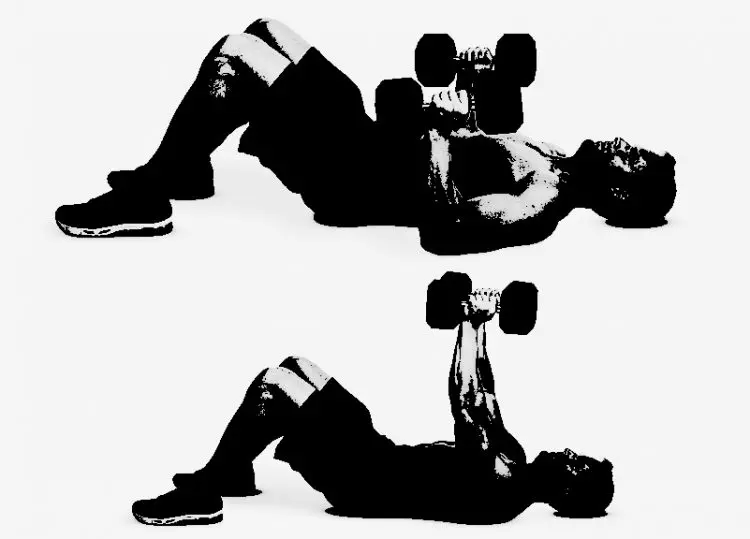
How to do it:
- Lie down on the floor with your chest facing up. Bend your knees and place your feet flat on the floor.
- Grab a pair of moderate-weight dumbbells with an overhead grip.
- Now extend your elbows to push the dumbbells towards the ceiling. This is the starting position!
- Now inhale and bend your elbows to slowly bring the weight down. Let the back side of the arms lightly touch the ground.
- Exhale as you push the weight back up.
- Repeat for recommended reps.
Pro tip: Keeping the elbows closer to the torso will emphasize more on triceps, and flaring out the elbows will emphasize more on chest development.
Benefits:
- It’s an excellent chest builder that will help you pack on muscle mass.
- The dumbbell floor press prevents excess stress on the shoulders because of limiting the range of motion.
- This exercise is not just for lifters who don’t have a bench; the dumbbell floor press is used by advanced lifters to improve their bench press performance while reducing the stress on their shoulders.
Muscle worked: Chest, shoulders, and triceps.
Rep range:
- Hypertrophy: 10-12 reps
- Strength: 1-5 reps
Note: Getting into the starting position with heavy dumbbells can be hard for many lifters. Please have a look at the video below to learn how to lift heavy during the dumbbell floor press.
Progression: Dumbbell stability ball press
Check out our in-depth guide to floor presses to learn how to do this exercise.
2. Dumbbell Stability Ball Press
A stability ball makes a great lightweight alternative to an exercise bench. In addition, the curved surface means your shoulders are free to move naturally, which may help take some stress off what is otherwise a much-abused joint. In addition, the unstable ball will increase shoulder stabilizer and core muscle activation, making your workout even more beneficial.
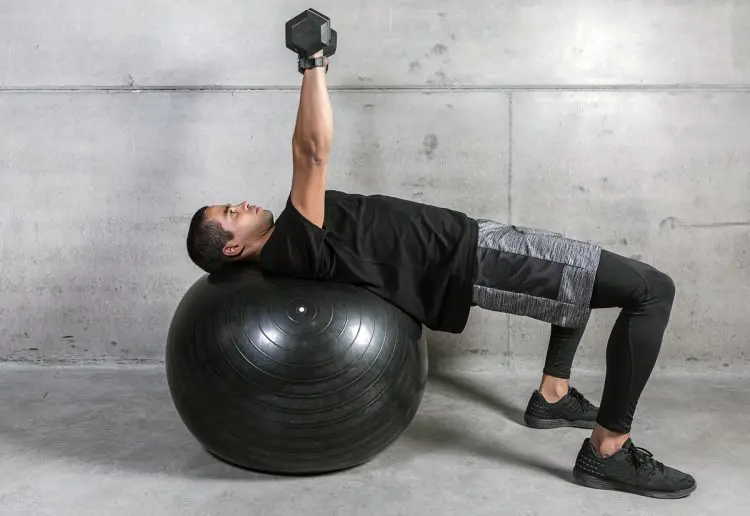
How to do it:
- Sit on your stability ball with a dumbbell in each hand. Rest the dumbbells on your legs. Brace your abs and pull your shoulders down and back.
- Keeping your arms bent, walk your feet forward and simultaneously lean back. Position the ball under your upper back and head. Brace your legs and core to stabilize your lower body.
- Press the weights up to arm’s length over your chest, lower them, and repeat.
- At the end of your set, lower the weights back to your shoulders and walk your feet in toward the ball, sitting up as you do so.
- Turn this exercise into an incline press by lowering your hips.
Pro tip: Instead of going heavy with the stability ball press, super-set this exercise with a heavy floor press. Example: do eight reps of floor press with 50-pound dumbbells, then grab a pair of 30-pound dumbbells to complete another ten reps of dumbbell stability ball press.
Benefits:
- Perfect exercise for those who love to feel a deep stretch during chest press.
- Training with the stability ball requires greater core engagement.
- It also teaches you to keep your core tight during exercise.
Muscle worked: Chest, shoulders, triceps, and core.
Rep range:
- Hypertrophy: 10-15 reps
- Strength: 5-8 reps
Progression: Dumbbell stability ball incline press
3. Dumbbell Floor Fly
Doing dumbbell flys on the floor will reduce your range of motion, but this helps eliminate momentum, which means you’ll have to work harder to lift the weights. This variation is also much more shoulder-friendly than regular dumbbell flyes.
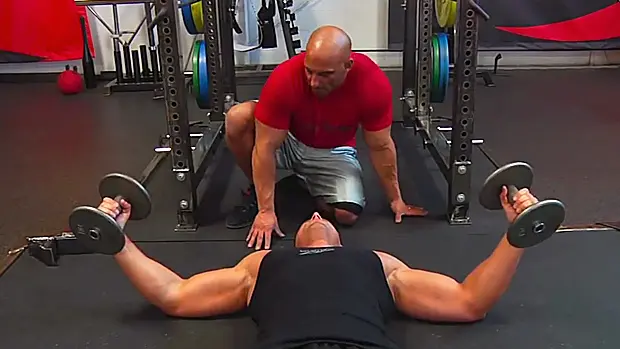
How to do it:
- Lie on the floor with your legs bent and feet flat. Press and hold your dumbbells up, palms facing inward. Bend your elbows slightly, but then keep them rigid.
- Open your arms and lower the weights until your upper arms touch the floor.
- Without bouncing, squeeze the dumbbells back up and together.
- You can also do this exercise with your legs straight if preferred.
Pro tip: Try for a three-second negative phase (eccentric movement) and a one-second concentric.
Benefits:
- An excellent chest isolation exercise that will help you develop a well-defined chest.
- Performing the dumbbell fly on the floor ensures you won’t be overstretching your pecs.
- Dumbbell flyes strengthen chest adduction and helps develop a chiseled inner chest.
Muscle worked: Chest, and anterior deltoid.
Rep range:
- Hypertrophy: 10-12 reps
- Strength: 3-5 reps
Progression: Dumbbell stability ball fly
4. Dumbbell Stability Ball Fly
The dumbbell stability ball fly is a great chest isolation exercise. While your triceps are involved, their involvement is relatively small. Using a ball means that, compared to floor flys, your range of motion is slightly greater. This may increase muscle activation.
How to do it:
- Sit on your stability ball with a dumbbell in each hand. Rest the dumbbells on your legs. Brace your abs and pull your shoulders down and back. With your arms bent, walk your feet forward and simultaneously lean back. Position the ball under your upper back and head. Brace your legs and core to stabilize your lower body.
- Press the weights up to arm’s length with your palms facing inward. Bend your elbows slightly, but then keep them rigid.
- Open your arms and lower the weights out and down until the weights are slightly below shoulder level. Take care not to overextend your joints.
- Without bouncing, squeeze the dumbbells back up and together.
- Turn this exercise into incline flyes by dropping your hips.
Pro tip: Focus on slow eccentric and fast concentric motion.
Benefits:
- Adding a stability ball increases the range of motion to feel a deeper stretch.
Muscle worked: Chest and shoulders.
Rep range:
- Hypertrophy: 8-10 reps
- Strength: 3-5 reps
Progression: Dumbbell stability ball Svend press.
5. Dumbbell Close-Grip Floor Press
The dumbbell close-grip floor press is a great way to get an effective chest workout without a bench and while using relatively light weights. This exercise is designed to maximize pec activation. If you are looking for a simple way to pump up your chest, this is the exercise for you.
How to do it:
- Lie on the floor with your legs bent and feet flat. Press and hold your dumbbells up over your chest, palms facing inward. Squeeze the weights together, pushing as hard as you can.
- Bend your elbows and lower the weights toward your chest while maintaining inward pressure. Lightly touch your upper arms to the floor.
- Push the weights back up and repeat.
- You can also do this exercise with your legs straight if preferred.
Pro tip: Keep the elbows close to the torso and pause at the bottom of every rep for two seconds.
Benefits:
- Builds stronger triceps and a well-defined inner chest.
- A close-grip floor press can be easier on your shoulders than a conventional dumbbell chest press.
Muscle worked: Inner chest, front delts, and triceps.
Rep range:
- Hypertrophy: 8-10 reps
- Strength: 1-5 reps
Progression: Dumbbell Svend press.
6. Dumbbell Narrow-Grip Stability Ball Press
Doing close-grip dumbbell presses on a stability ball means you can use a slightly bigger range of motion than lying on the floor. Also, as the ball moves, you’ll need to work a little harder to maintain your position, increasing stabilizer muscle activation in the process.
How to do it:
- Sit on your stability ball with a dumbbell in each hand. Rest the dumbbells on your legs. Brace your abs and pull your shoulders down and back.
- Keeping your arms bent, walk your feet forward and simultaneously lean back. Position the ball under your upper back and head. Brace your legs and core to stabilize your lower body. Squeeze the weights together, pushing as hard as you can.
- Starting with the weights on your chest, push them up to arms’ length, and then lower them again. Keep pushing the weights in and together.
- At the end of your set, lower the weights back to your shoulders and walk your feet in toward the ball, sitting up as you do so.
- Turn this exercise into an incline close-grip press by lowering your hips.
Pro tip: A great variation to be added to your chest superset. Perform a set of heavy close-grip floor presses and then do another ten reps by lowering the weight and introducing a stability ball.
Benefits:
- Adding a stability ball to the movement improves muscle coordination and engagement.
- It will improve your body balance.
- A stability ball allows you to achieve a bigger range of motion.
Muscle worked: Chest, triceps, and core.
Rep range:
- Hypertrophy: 10-12 reps
- Strength: 1-5 reps
Progression: Dumbbell floor press.
7. Dumbbell Svend Press
The dumbbell Svend press is a lot like narrow-grip dumbbell presses. However, this exercise is done standing rather than lying on the floor or on a stability ball. Also, for this move, you only need a single dumbbell. Despite this, it’s still an effective chest exercise.
How to do it:
- Stand with your feet shoulder-width apart, knees slightly bent. Brace your abs and pull your shoulders down and back. Hold a dumbbell between the palms of your hands in front of your chest. Press your hands inward.
- Maintaining inward pressure, push the dumbbell out to arm’s length. Keep your arms up and parallel to the floor.
- Bring the weight back to your chest and repeat.
Pro tip: Focus on the tempo and feel the muscle contraction.
Benefits:
- Excellent isolation exercise that improves mind-muscle connection.
- It’s also a great chest workout finisher.
Muscle worked: Chest, shoulders, and triceps.
Rep range:
- Hypertrophy: 8-10 reps
- Strength: 3-5 reps
Progression: Dumbbell close grip floor press.
8. Dumbbell Push-up
You don’t have to press your dumbbells to get a good chest workout. In fact, they make perfect push-up handles so you can pump up your pecs while using your body weight for resistance. Using dumbbells means you can lower your chest between your hands, increasing your range of motion and the difficulty of this classic exercise.
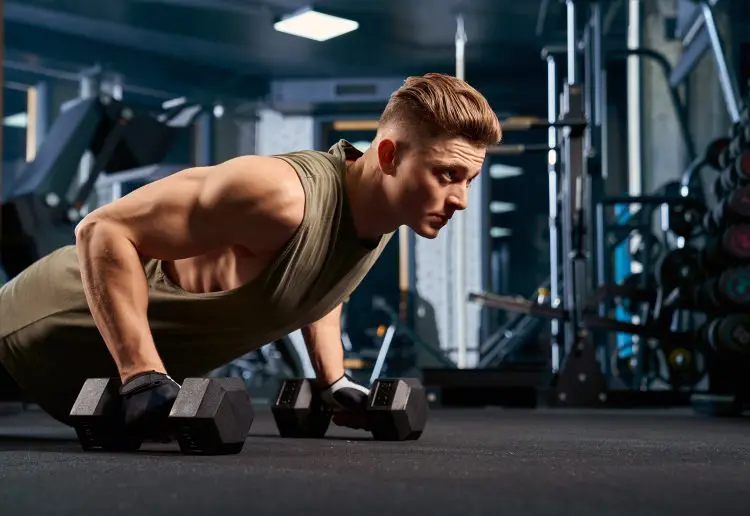
How to do it:
- Holding a dumbbell in each hand, squat down and place the weights on the floor, about shoulder-width apart. Your hands should be facing inward.
- Walk your feet out and back, so your body is in a straight line. Brace your abs and pull your shoulders down and back.
- Bend your arms and lower your chest between your hands and toward the floor. Take care not to hyperextend your shoulders.
- Push yourself back up and repeat.
- Make this exercise easier by bending your legs and resting on your knees. Make it more challenging by raising your feet.
Pro tip: Two-second pause at the bottom of the movement.
Benefits:
- A compound movement that will improve full body strength.
- Dumbbell push-ups allow you to experience a better range of motion.
- Mitigates wrist pain.
Muscle worked: Chest, shoulders, triceps, and core.
Rep range:
- Hypertrophy: AMRAP
- Strength: 1-5 reps of weighted push-ups.
Progression: Feet elevated dumbbell push-up.
9. Dumbbell Stability Ball Pull-over
Pull-overs are often thought of as a lat exercise, but they’re also an effective chest builder. You don’t need a bench to do pullovers; you can also do them using a stability ball. However, you should be careful while using heavy weights. You may need to anchor your feet under a sturdy object to avoid accidentally doing a backflip over the ball!
How to do it:
- Sit on your stability ball with a dumbbell in each hand. Rest the dumbbells on your legs. Brace your abs and pull your shoulders down and back.
- Keeping your arms bent, walk your feet forward and simultaneously lean back. Position the ball under your upper back and head. Brace your legs and core to stabilize your lower body. Press the weights up and over your chest. Press them together. Bend your elbows slightly but then keep them rigid.
- Lower the weights back and over your head until your biceps are next to your ears.
- Pull the weights back up and over until your arms are vertical.
- You can also do this exercise using one dumbbell.
Pro tip: Keep your hips almost parallel to the chest to improve chest engagement. Also, keep your elbows flared out for better chest activation; keeping the elbows close to the torso will engage lats.
Benefits:
- Dumbbell pullover is one of the few exercises that strengthen the serratus anterior.
- Adding stability ball to the pullover increases core engagement and improves balance.
- Stability ball also allows a greater range of motion.
Muscle worked: Chest, serratus anterior, and latissimus dorsi (lats).
Rep range:
- Hypertrophy: 10-12 reps
- Strength: 1-5 reps
Progression: High bear crawl.
10. Dumbbell Renegade Row and Push-Up
This exercise adds a row to dumbbell push-ups (exercise #8). This not only means they work your upper back, but they also increase pec activation because your muscles will be under tension for longer, and you also need to stabilize your upper body using just one arm. This is also a very effective core exercise.
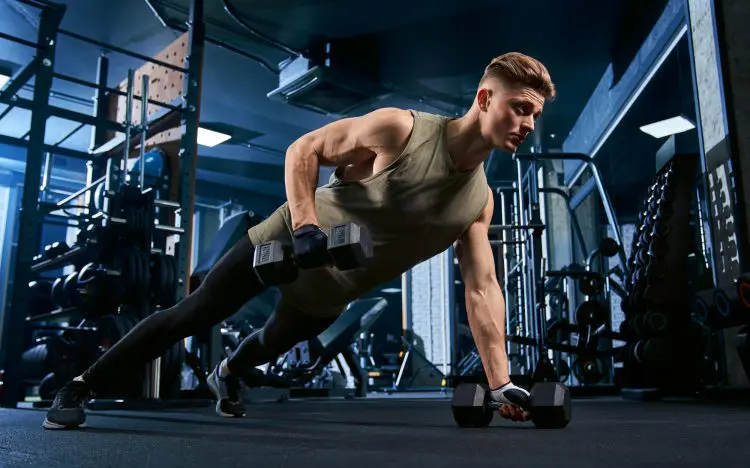
How to do it:
- Holding a dumbbell in each hand, squat down and place the weights on the floor, about shoulder-width apart. Your hands should be facing inward.
- Walk your feet out and back, so your body is straight. Brace your abs and pull your shoulders down and back.
- Keeping your body straight and your hips and shoulders level, bend one arm and pull the dumbbell up and into your ribs. Place it back on the floor, and then do the same thing on the other side.
- Next, bend your arms and lower your chest down between your hands.
- Push yourself back up and repeat the row/row/push-up sequence for as many reps as required.
Pro tip: Do not hurry; maintain a controlled tempo.
Benefits:
- Dumbbell renegade row and push-up is an excellent compound exercise that strengthens the chest, shoulders, triceps, lats, and core.
- Improves strength and core stability.
- Boosts metabolism and helps you torch calories.
Muscle worked: Chest, shoulders, triceps, lats, and core.
Rep range:
- Hypertrophy: 8-12 reps
- Strength: 1-5 reps
Progression: Weighted dumbbell renegade row and push-up.
11. Feet-Elevated Dumbbell Push-up
Some people also call it “incline dumbbell push-ups.” This push-up variation emphasizes upper chest and shoulder development.
How to do it:
- Grab a pair of dumbbells and get into a push-up position.
- Now place your feet on an elevated surface like a bench or stool.
- Keep your hands in a neutral position and bend your elbows to lower your body towards the floor.
- Go deep until you feel a stretch in your upper chest and shoulders.
- Pause for two seconds before pushing yourself up to the starting position.
- Repeat for as many reps as possible.
Pro tip: Increase the intensity by controlling the tempo. Do four seconds of eccentric motion, two seconds pause at the bottom, and one-second concentric motion.
Benefits:
- It’s an upper body strength builder.
- It improves chest definition and will help you develop a thick chest.
Muscle worked: Upper chest, front delts, and triceps.
Rep range:
- Hypertrophy: AMRAP
Progression: Weighted feet elevated dumbbell push-up.
Level Up Your Fitness: Join our 💪 strong community in Fitness Volt Newsletter. Get daily inspiration, expert-backed workouts, nutrition tips, the latest in strength sports, and the support you need to reach your goals. Subscribe for free!
12. Standing Dumbbell Upward Fly
Standing dumbbell upward fly may look like a front delt raise, but it is targeting the upper chest and shoulders.
The main difference between a dumbbell upward fly and front delt raise is the grip and movement pattern; having an overhand grip pays more emphasis on the shoulders, and an underhand trip emphasizes more on the upper chest.
How to do it:
- Stand with your feet shoulder-width apart.
- Grab a pair of lightweight dumbbells with an underhand grip.
- Keep your chest up and chin straight.
- Brace your core while maintaining a slight bend in the elbows.
- Lift the dumbbells up to shoulder height while contracting your pecs. Internally rotate your wrists and bring your arms closers as you move the dumbbells up; it will help with muscle contraction.
- Slowly lower the dumbbells to the starting position.
- Repeat for recommended reps.
Pro tip: If you find it challenging to feel the contraction in your upper chest; grab a pair of lightweight dumbbells, close your eyes and perform the exercise using a slow tempo. This should help you establish a better mind-muscle connection.
Benefits:
- It’s a great upper chest isolation exercise.
- Allows a better range of motion which improves mobility.
Muscle worked: Upper chest and front delts.
Rep range:
- Hypertrophy: 8-10 reps
- Strength: 1-5 reps
Progression: Incline dumbbell fly with the stability ball.
13. Dumbbell Single-Arm Floor Fly
This advanced version of floor fly will allow you to train your chest unilaterally.
How to do it:
- Lie on the floor with your legs bent and feet flat on the floor. Grab a dumbbell with a neutral grip. Bend your elbows slightly.
- Lower the weights out and down until the tricep of the working arm touches the floor.
- Pause for two seconds and then squeeze the chest to get the dumbbell back up to the center of the body.
Pro tip: Don’t try to go too heavy; it’s an isolation exercise used to correct strength and muscle imbalances.
Benefits:
- Improves mind-muscle connection and unilateral chest isolation.
- It also develops strength and mobility.
Muscle worked: Chest and shoulders.
Rep range:
- Hypertrophy: 10-12 reps
- Strength: 5 reps
Regression: Dumbbell floor fly.
14. Reverse-Grip Dumbbell Floor Press
The reverse-grip dumbbell floor press is an excellent exercise that targets the upper chest while reducing the stress on your shoulders. Anyone who experiences shoulder pain while chest training should try this variation.
The reverse grip dumbbell press also helps in building stronger triceps.
How to do it:
- Lie down on the floor with your chest facing up. Keep your feet flat on the floor with your knees bent.
- Grab a pair of moderate-weight dumbbells using a supinated grip.
- Keep your elbows close to the torso.
- Now extend your elbows to push the dumbbells up over your chest. This is the starting position.
- Now inhale and bend your elbows to slowly bring the weight down to the sides of your chest. Let the arms touch the ground.
- Exhale and push the weight back up.
- Repeat for the recommended number of reps.
Pro tip: It’s an unconventional exercise, and you should start with a pair of lightweight dumbbells. Perform the first set with a high number of repetitions to establish a better mind-muscle connection.
Benefits:
- It’s an upper-chest-focused exercise that allows you to go heavy.
- It reduces the pressure on your shoulders.
- It also helps in the development of bigger triceps.
Muscle worked: Chest and triceps.
Rep range:
- Hypertrophy: 10-12 reps
- Strength: 1-5 reps
Regression: Dumbbell close grip floor press.
15. Dumbbell Floor Fly with a Twist
Now a variation that will improve chest engagement.
It’s just like a conventional dumbbell fly, but you rotate your wrist outward as you lift your arms.
How to do it:
- Lie on the floor with your legs bent and feet flat. Press and hold your dumbbells up, palms facing towards your head. Maintain a slight bend in your elbows.
- Lower the weights and externally rotate the wrist to feel a deep stretch in your pecs.
- Pause at the bottom.
- Rotate your wrist as you bring the weight up to the starting position.
- You can also do this exercise with your legs straight if preferred.
Pro tip: Control the eccentric motion.
Benefits:
- A slight rotation in the wrist has a big impact on chest activation. It allows a better mind-muscle connection.
- Better muscle pumps.
Muscle worked: Chest.
Rep range:
- Hypertrophy: 8-10 reps
- Strength: 5 reps
Regression: Dumbbell floor fly.
16. Incline Fly on an Exercise Ball
The incline fly is one exercise that cannot be done on a flat floor, but you can do it with an exercise ball.
Doing the chest fly on the stability ball also improves the range of motion by allowing you to spread your arms.
How to do it:
- Grab a pair of lightweight dumbbells and sit on the ball.
- Keeping your arms bent, walk your feet forward and simultaneously lean back. Position the ball under your upper back and head.
- Position your feet at shoulders-width.
- Press and hold your dumbbells up, palms facing each other. Bend your elbows slightly.
- Lower the weight until your arms are parallel to the floor.
- Exhale and return to the starting position.
- Repeat for recommended reps.
Pro tips: Slight wrist supination as you move the weight up will improve muscle contraction.
Benefits:
- It allows you to replicate the incline dumbbell fly on the bench.
- Chest fly strengthens chest adduction.
- Incline fly is a great exercise to improve inner chest definition.
Muscle worked: Chest and shoulders.
Rep ranges:
- Hypertrophy: 8-10 reps
- Strength: 1-5 reps
Regression: Dumbbell floor fly.
Benefits of Using Dumbbells
Given below are some benefits of using dumbbells over barbells:
1. Greater Range of Motions
Dumbbells allow a greater range of motion than barbells, period! While doing the bench press, how deep can you go? You can stretch out your chest until the barbell touches your chest. But in the case of dumbbells, you can achieve a deeper pectoral stretch by letting the dumbbells go below the chest level.
2. Provides More Stability
When you train with dumbbells, each hand moves independently. This means each hand has to exert an equal amount of pressure, thus making the body work harder to stabilize the movement.
Additionally, independently controlling the dumbbells in each hand develops better shoulder and grip stability.
3. Enhanced Strength
Whether you are training with a barbell or dumbbells, both are going to help in strength development, but dumbbells engage more stabilizers because of a bigger range of motion.
Enhanced stabilizer engagement not only reduces the chances of injuries but also makes you a more capable lifter.
4. Chest Growth
What are the factors responsible for muscle growth?
- Range of motion: Training with a full range of motion produces greater muscle hypertrophy. Dumbbell training facilitates a greater range of motion than barbell training. [1]
- Symmetrical development: Dumbbells force symmetrical muscle development by allowing each hand to work independently. Additionally, you can also perform unilateral exercises to strengthen the weak regions. Symmetrical strength development improves the quality of your training and prevents muscle imbalance.
- Better muscle contraction: Dumbbells allows some exercises that cannot be done with barbells. Example: the dumbbell fly with a twist. This exercise allows you to rotate your wrist internally to experience greater muscle coordination.
5. Dumbbells Don’t Stress Your Joints
Many lifters prefer dumbbells because they allow them to adjust their grip, elbow positioning, and scapular mobility according to the movement, therefore making dumbbells a joint-friendly option.
Dumbbell-Only Chest Workout
While there is nothing wrong with picking 3-4 exercises from this article and calling it a workout, you’ll get better results if you follow a more structured plan. Build your chest using nothing but dumbbells with our tried-and-tested workout. To make this workout more accessible, we are assuming that you don’t have a stability ball.
Before you start, take a moment to warm up your muscles. Start your warm-up with 5-10 minutes of cardio, followed by a few dynamic stretching and flexibility exercises, focusing on your upper body and especially your shoulders. Finish your warm-up with a couple of light sets of the first 1-2 exercise.
Do the following workout 1-2 times per week as part of a split routine. If you do it twice, make sure you have a few days between to allow for adequate rest and recovery, e.g., Tuesday and Friday.
- Dumbbell floor fly
- Dumbbell floor press
- Dumbbell push-ups
- Dumbbell close grip floor press
- Dumbbell Svend press
Regarding sets and reps, 2-4 sets of each exercise should be plenty. If you feel you can do more than four sets, you probably need to work a little harder — maybe take shorter rests between sets. Ideally, your rep count per set should match your training goals, i.e.:
- Strength – 3-5 reps per set
- Hypertrophy – 6-12 reps per set
- Endurance – 13-20 reps
However, if this is not possible — perhaps because you only have light dumbbells to train with — just rep out until you are close to failure. That way, your workout will still be productive.
Read also: Dumbbell Chest Workout Routine For More Size In 4 Weeks
Beginner Dumbbell-Only Chest Workout Without a Bench
This workout program will help you create a strong foundation if you have just started your fitness journey.
Beginner-level dumbbell chest workout without a bench:
| Exercise | Sets | Reps | Rest | |
| 1. | Push-up | 3 | 8-10 | 60 seconds |
| 2. | Dumbbell floor press | 4 | 10-12 | 60 seconds |
| 3. | Dumbbell close-grip floor press | 3 | 10-12 | 60 seconds |
| 4. | Dumbbell floor fly | 4 | 8-10 | 60 seconds |
| 5. | Dumbbell floor pull-over | 3 | 10-12 | 60 seconds |
Intermediate Dumbbell-Only Chest Workout Without a Bench
Intermediate-level dumbbell chest workout without a bench:
| Exercise | Sets | Reps | Rest | |
| 1. | Plyo push-ups | 4 | 8-10 | 60 seconds |
| 2. | Dumbbell stability ball press | 4 | 10-12 | 60 seconds |
| 3. | Reverse grip dumbbell floor press | 4 | 10-12 | 60 seconds |
| 4. | Feet elevated dumbbell push-up | 4 | 10-15 | 60 seconds |
| 5. | Dumbbell floor flies | 4 | 8-10 | 60 seconds |
| 6. | Dumbbell Svend press | 3 | 10-12 | 60 seconds |
Advanced Dumbbell-Only Chest Workout Without a Bench
This advanced-level no-bench chest workout will take your chest strength and muscle pumps to another level:
| Exercise | Sets | Reps | Rest | |
| 1. | Dumbbell stability ball press | 4 | 8-10 | 60 seconds |
| 2. | Standing dumbbell upward fly | 4 | 10-12 | 60 seconds |
| 3. | Dumbbell stability ball pullover | 4 | 10-12 | 60 seconds |
| 4. | Dumbbell close grip floor press | 4 | 10-15 | 60 seconds |
| 5. | Dumbbell fly with twist | 4 | 8-10 | 60 seconds |
| 6. | Dumbbell Svend press | 3 | 10-12 | 60 seconds |
Tips to Amp Up Dumbbell Chest Exercises
We have some valuable suggestions that you can follow to improve your chest training performance. Let’s have a look:
1. Nutrition:
You might need to fix your diet if you are working hard but cannot see the desired results.
Getting your nutrition right should be the first thing you do to amp up your performance. Focus on the macro distribution, total calorie intake, pre-workout, and post-workout meals.
Total calorie intake: Do you know your daily caloric requirements? This is a fundamental question that you need to answer. Knowing your daily caloric needs will help you plan your meals. If the goal is to get lean, you should eat 300 fewer calories than the daily maintenance calories, but if your goal is to gain muscle and size, then you should aim to increase the daily calories by 500.
Macronutrient distribution: Determining your macro goals is essential. Check out our convenient online macronutrient calculator to find out your ideal macro breakdown.
2. Sleep Tight

Sleep is when your body conducts the healing process, and you should sleep for at least 7-8 hours of daily sleep. Sleep is when your body releases hormones that play a crucial role in recovery.
Optimize your sleep quality by being consistent with your sleep routine, having a warm shower before bed, eliminating all sources of light, restricting your phone usage two hours before sleep time, setting up the room temperature between 60 and 65 degrees Fahrenheit, and restricting caffeine and alcohol intake.
3. Focus on Strengthening Your Stabilizers
This is something that many people ignore. Many lifters emphasize training bigger muscle groups but neglect the importance of stabilizers. Stabilizers are secondary muscles that play a significant role in the quality of your lift.
For example, a lifter with a weak scapula will have difficulty doing the bench press; weak triceps also restrict power generation.
If your focus is to build a stronger chest, start emphasizing the strength of the triceps, grip, scapula, and core. These muscles can drastically improve your pushing performance.
What Kind of Dumbbells Should I Buy for Chest Workout?
If you are planning to train at home, chances are, you might be confused between buying a set of fixed dumbbells or an adjustable dumbbell. Don’t worry; we got your back! What you’ll read next will help you with the decision.
Unfortunately, there is no one size fits all solution; both fixed-weight dumbbells and adjustable-weight dumbbells are good buys; some lifters might like the adjustable-weight dumbbells, while some may like the robust and old-school fixed-weight dumbbells. Your buying decision should depend on the following factors:
- Training experience
- Space and budget
- Utility
1. Training Experience
When we say training experience, we mean your ability to handle weight properly.
Experienced lifters often require a wide range of weights to perform different exercises. You can not expect yourself to perform dumbbell floor presses and dumbbell flies with the same weight, right?
Adjustable dumbbells allow you to easily swap between weights and help you progressively overload the target muscles.
With the fixed-weight dumbbells, you will need to invest in different sets of dumbbells. Additionally, you will be required to buy new pairs every time you get stronger or want to increase the overload.
2. Space and Budget
Space and budget are important factors that should be considered. Adjustable weight dumbbells are a one-time investment that will liberate you from buying different sets of dumbbells. Additionally, they won’t be occupying large spaces.
Buying a pair of fixed-weight dumbbells might sound like a cost-effective option, but it will make you spend a lot more in the near future. Many people start by buying a pair of fixed-weight dumbbells, then have to buy heavier dumbbells as they stronger. Then you will realize that some exercises can not be done with heavy dumbbells and need light-weight dumbbells too. Soon you will end up having 7-8 pairs of dumbbells. Additionally, you will be required to buy a dumbbell rack to organize them properly.
3. Durability
Adjustable dumbbells are sophisticated and need to be handled with care. Additionally, those dumbbells will not work the same forever; adjustable dumbbells may break down after a few years of rough usage. You are obviously not allowed to throw them like the way you throw your fixed-weight dumbbells after a chest press.
Fixed-weight dumbbells are very durable, and they are going to stay with you for decades. Fixed weight dumbbells are soo durable that they can be used by generations. The chances of malfunctioning are meager.
Frequently Asked Questions
How should I stretch before a dumbbell chest workout?
You should not stretch your pecs before a workout; stretching reduces the muscle’s ability to lift heavy.
Instead, opt for pre-workout mobility and activation drills. Before a chest workout, work on the shoulder, elbow, and wrist mobility to get the blood flowing into these crucial joints.
For muscle activation, perform resistance band pull-aparts for scapula activation, some plyo push-ups to activate the chest, and lightweight rope triceps pushdown to wake up all the primary muscle groups required for the chest workout.
Can beginners do dumbbell chest exercises?
Yes, of course! Dumbbells are good for people of any experience level.
If you are a beginner, start with light-weighted dumbbells, and stay away from ego lifting.
Which exercise is best for the chest, the one done with dumbbells or a rod?
Every exercise has its benefits, and what is good for you depends on your requirements. Let’s have a look at them:
- Training for strength: A barbell bench press works best.
- Training for size and definition: A dumbbell bench press will allow greater chest activation and better muscle contractions.
- Improve the size of your upper chest: Do an incline dumbbell press and reverse grip bench press.
- Want a visible mid-line: Dumbbell fly is one of the best exercises for that.
Why do I feel it in my arms only and not in my chest when I do chest workouts?
Warm up your chest before you start the actual training.
You can’t feel your chest because you cannot establish a mind-muscle connection with the target muscle. Here are some practical tips for improved chest engagement:
- Do chest activation drills before the workout: Some push-ups, lightweight cable crossovers, and single-hand dumbbell flies should help you activate chest muscle fibers for better contractions.
- Slow down the tempo: Slowing the tempo has helped many lifters establish a better connection with the muscle fibers. Four seconds of eccentric motion and two seconds of concentric motion should work well.
- Pause at the bottom: Two seconds of pause at the bottom of the movement should help you feel the muscle far better.
- Close your eyes to feel the contraction: Stop ego lifting, grab a pair of lightweight dumbbells and get into the pressing position. Now close your eyes and try to feel every contraction; this drill should help you feel the chest while training.
Wrapping Up
Training with nothing but dumbbells is not ideal and means your workouts will be pretty limited and restrictive. That said, while it is something of a disadvantage, you can make it work.
Combine your dumbbells with some well-chosen bodyweight exercises like push-ups and dips, and you’ve got yourself a more rounded, effective program.
Do not think for a moment that lack of equipment means you cannot work out; you can! Ultimately, your body struggles to differentiate between doing chest presses on a state-of-the-art machine and push-ups in your dingy basement. So long as you train hard and consistently, your body will adapt, and you will get results. Anyone who tells you differently is probably trying to sell you something!
References
- Schoenfeld B J, Grgic J. Effects of range of motion on muscle development during resistance training interventions: A systematic review. SAGE Open Med. 2020; 8: 2050312120901559. doi: 10.1177/2050312120901559. PMID: 32030125

